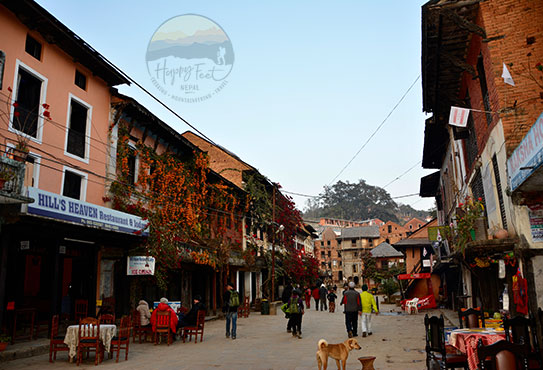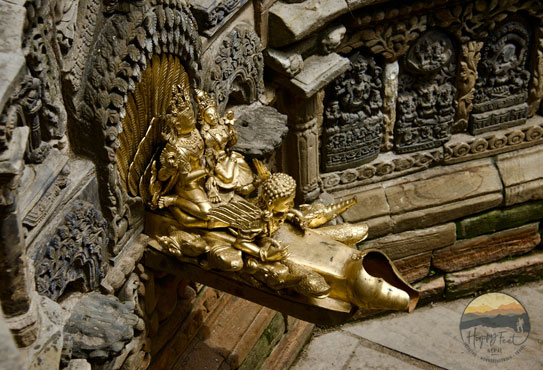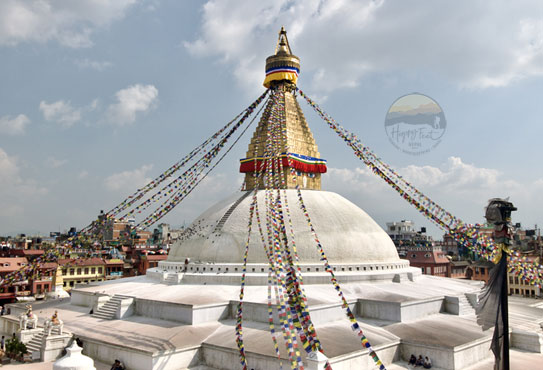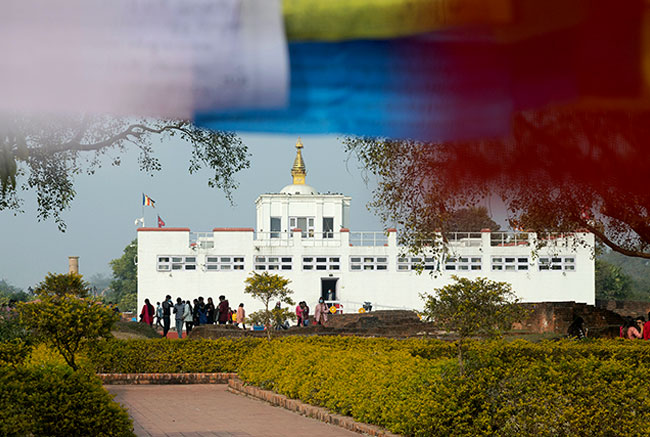Sunday - Friday: 9 AM - 4 PM
Best of Nepal tour and Jungle Safari, 13 days
Kathmandu valley, Pokhara, Tansen, Lumbini, Chitwan and sightseeing of Mount Everest
Guided Tour of Nepal visiting six World Heritage Sites by UNESCO into Kathmandu valley. Visit Pokhara, in front of the Annapurna massif. Visit Tansen and Lumbini, the sacred-most site where Kakusandha Buddha, Kanakamuni Buddha, Kassapa Buddha, and Siddhartha Gautama Buddha were born. And safari in the Chitwan National Park, listed as World Heritage Site by UNESCO, Asia’s most important Natural Park. And fly over Mount Everest to see the entire Himalayan Range.
Tour profile:
Arrive in Kathmandu, customs and immigration formalities and claim your baggage, which takes some time. Upon exiting, the arrivals get a traditional welcome from the Happy Feet Nepal representative and transfer to the hotel. Reach the hotel and the rest of the day is free with the possibility of optional excursions (not included), but you can ask to organise any of the tours or stroll through its vibrant streets.
Kathmandu, the capital and heart of the country with three medieval cities, symbolises Nepal’s everything. Having lived through the several ruling dynasties of Buddhists and Hindus, the culture and society of Kathmandu Valley have evolved through time to give it more than a unique feature. Today it is an urban city, and still rapidly increasing, that has its ancient myths and, at the same time, is testimony to the greatness of people who have lived there for time immemorial.
Accommodation in Hotel Shanker, a 4-star hotel.
Breakfast at the hotel. In the morning, visit Swayambhunath, dating back more than 25 centuries and one of the world’s oldest Buddhist chaityas. The great stupa of Swayambhunath is a landmark wonder of Nepal and is listed as a World Heritage Site. The all-seeing eyes of Lord Buddha keep an eternal watch over the valley.
Swayambhu is located west of Kathmandu proper on a hillock about 500 feet above the valley floor. The hill is a mosaic of small chaityas and pagodas—one Hinayana (Theravada) and five Mahayana (Vajrayana)—temples. The site offers a complete view of Kathmandu Valley, its surroundings, and the northeastern Himalayas.
In continuity, drive to Patan, one of the three medieval cities of Kathmandu Valley and one of the World Heritage sites among the seven World Heritage sites of Kathmandu Valley, located 7-kilometres southwest of Kathmandu. The city known as Lalitpur, the City of Arts, was a renowned Buddhist centre in Asia and has four Ashoka-built Stupas and a multitude of miniature stupas, monasteries, viharas and temples. At Patan, we visit its Durbar Square, the Golden Temple, Thousand Buddha, and its museum, among other sites, which explain Buddhism and Hinduism in extensive labels within the living traditions and context.
In the afternoon, drive to Basantapur Durbar Square, also known as Kathmandu’s Durbar Square. The tour of the Kathmandu Durbar Square, classified as a World Heritage Site, teems with activity. It features countless monuments, including the House of the Living Goddess (Kumari Ghar), the ferocious Kal Bhairab and the kneeling Hanuman (the red-capped monkey god) statues.
The architecture represents some of the greatest achievements of the medieval Malla era. The stroll leads around the square past a host of pagoda temples (including the grand temple of the goddess Taleju) and a window framing Shiva and Parbati sitting together viewing the scene.
The square is full of colourful life centred on the Kasthamandap rest-house. Said to have been built with wood from a single tree (and the origin of Kathmandu’s name), it is now reconstructed in the wake of the 2015 earthquake. Then visit the Temple of Kumari; the residential quarters of the Living Goddess called Kumari (‘chaste virgin’) consists of a traditional building complex featuring carved wooden balconies and windows.
Also impossible to overlook are the great bell and large drums. The palace’s main golden gate is guarded by the monkey god Hanuman, the faithful devotee of Lord Ramachandra, the hero of the epic Ramayana.
Finally, pass through the Hanuman Dhoka: the historic seat of the past Malla and Shah dynasties. The historic temples and palaces epitomise the religious and cultural lifestyle of the rulers. Among the most interesting things to view is the Taleju Temple, built by King Mahindra Malla in A.D. 1549 and a historical museum containing artefacts of past Shah kings.
We finalise with the tour and ride a rickshaw and roll through its old city market centre, the Ason Bazaar, seeing what the Nepalese people buy and sell in their daily run.
Accommodation in Hotel Shanker, a 4-star hotel, breakfast included.
Breakfast at the hotel and drive to Pashupatinath Temple. A pagoda temple with gilt roofs, carved with silver doors dedicated to Lord Shiva, situated at the bank of the holy Bagmati River, and regarded as among the most sacred temples of the Hindu religion, Pashupatinath is the focus of pilgrimages culminating in the day of Shiva Ratri (the marriage anniversary of Lord Shiva and the goddess Parvati). Pashupati is also the cremation ground in the ghats (cremation group) along the bank of River Bagmati, where the recently deceased Hindus of the Valley are cremated.
Then visit the Boudhanath, the largest Buddhist shrine in South Asia. This ancient Chorten was built in the 5th century A.D. by King Manadeva. A series of three terraces lead up through water, fire and air segments to the pinnacle, symbolic of space and the highest spiritual attainment. The whole is surrounded by a circle of shops which form a small Tibet. Lord Buddha’s four pairs of eyes flash vividly into the cardinal directions, radiating the message of Mahayana Buddhism, known as Lamaism in Sikkim, Ladakh, Bhutan and Tibet.
Then we take a 13-kilometres drive to Bhaktapur, east of Kathmandu. Its original name is, Bhadgaon or the village of Devotees, and it is one of Kathmandu Valley’s living museums. Bhaktapur is filled with the 55-windowed Royal Palace, the Palace of the Kumari, the temple of Taleju, the temple of Pashupati, the main square of Taumadhi Tole, Nyatapola Temple (the most imposing the tallest such architecture in all of Nepal), the temple of Akash Bhairab (the second most important temple of Bhadgaon), the Dha Hateya and the Square of the Potters. UNESCO recognises Bhaktapur as a World Heritage Site.
After the visit, we leave by road toward Nagarkot, at an altitude of 2,100m and 32 kilometres east of Kathmandu or 19 kilometres northeast of Bhaktapur. Nagarkot is one of the most beautiful hill resort areas to enjoy sunrises and Mountain Range views, from the Langtang to Everest.
Accommodation at the Club Himalaya, a 4-star hotel, breakfast included.
210km – 6hrs drive.
Sunrise view tour. Breakfast at the hotel and departure by road to Pokhara, located 200 kilometres west of Kathmandu, is the third-largest city in the country. Due to its location, the temperature is always warmer than in Kathmandu. The driving takes you through an exciting highway of the country overlooking mountains and hills and scattered villages until we reach Pokhara. The Annapurna Mountain, Machhapuchhre Himal, and Lamjung Mountains rim the northeastern horizons of the town.
Accommodation in Hotel Temple Tree, a 4-star hotel breakfast included.
Breakfast at the hotel and transfer 13-kilometres to Pumdikot, a strategic hill with an ancient fort in ruins and recently converted into a Shiva temple; it is a beautiful viewpoint. The views of Annapurna, Pokhara and the peace stupa are beyond description. From Pumdikot, we take a scenic drive to Peace Stupa, enjoying magnificent views of Phewa Lake, the Himalayas, Pokhara City and its surroundings. The Peace Stupa site is equally beautiful, with splendid views.
The World Peace Stupa stands gloriously on a hill saddle above Phewa Lake and Pokhara City from where you get panoramic views of Phewa Lake, the city of Pokhara and Mount Annapurna and Lamjung (on a clear day). A Peace Stupa is a Buddhist monument to inspire peace in all races and creeds and to help unite them in their quest for world peace. Most of them were built since World War II under the direction of Nichidatsu Fujii (1885-1985), a Buddhist monk from Japan and founder of the Nipponzan-Myohoji Buddhist Order. In 1947, he started the construction of peace pagodas as world peace shrines, and in the year 2000, there were eighty Peace Pagodas built around the world between Europe, Asia and the United States.
Enjoy the landscapes of the site, visit the stupa, explore, go down to the lake shore, cross the lake by little boat, have a late lunch and visit the International Mountain Museum in Pokhara, where we will see and better understand the history of the mountain and mountaineering on the highest peaks in the world. We will understand the importance of the Himalayas of Nepal and the benefits that the Himalayas give to the millions of people and their natural habitat. After the visit, return to the shore of the lake for free time.
Accommodation in Hotel Temple Tree, a 4-star hotel, breakfast included.
117km – 4hrs drive.
Early in the dawn, sunrise view tour to Sarangkot viewpoint. Sarangkot, the most famous lookout in Pokhara, offers a grand panorama of the Annapurna ranges, Machhapuchare, Manaslu, Lamjung Himal, and Dhaulagiri range. From the Sarangkot lookout, you can also see the beautiful view of Pokhara Valley and its unique landscapes with Lake Phewa, Lake Begnas and Lake Rupa. A short 25-minute drive from the hotel in Pokhara lakeside puts you on Sarangkot, which offers a striking view of sunrise and a platform for Paragliding. Finalise the tour and drive back to the hotel for breakfast.
Then continue an exciting drive to Tansen. Tansen is the city in the lap of Srinagar Hill, a beautiful summer resort above the plains of Lumbini. Srinagar offers spectacular views of mountains and valleys. Tansen is one of the oldest towns with an age-old cultural heritage and traditions that link with the time of Sakyas, the families of Gautama Buddha. Arrive at Tansen, check into the hotel, have lunch, take a sightseeing walk to Srinagar Hill, and visit the colourful Tansen Bazaar.
Accommodation in Hotel Srinagar, a 2-star hotel, breakfast included.
83km – 3hrs drive.
Breakfast at the hotel and drive to Lumbini; the elevation drops more than 1000 metres in the shortest time. Lumbini is amongst Nepal’s fertile land and is where the Siddhartha Gautama Buddha, the enlightened one, took his birth. The entire land is the sacred-most site; several Buddhas, such as the Kakusandha Buddha, the Kanakamuni Buddha and the Kassapa Buddha, were born here before the birth of Siddhartha Gautama Buddha. Arrive at Lumbini, check into the hotel, and have lunch. In the afternoon, visit the Maya Devi Temple, the Asoka pillar, Peace Stupa and several monasteries built by different countries such as China, Japan, Sri Lanka, Myanmar, Germany, Thailand, and Korea in their respective architectural charms.
Accommodation in Hokke Hotel, a 3-star hotel, breakfast included.
You will spend a full day in Lumbini visiting different monasteries and Tilaurakot, where Buddha spent 29 years. The monastic area developed in the World Buddhist Centre with monasteries built by Buddhist communities from different countries. After lunch, he will take a short drive to Tilaurakot to see the ruins of the Shakya kingdom, where Buddha spent 29 years 2500 years before.
Accommodation in Hokke Hotel, a 3-star hotel, breakfast included.
107km – 3 1/2 hrs drive.
Breakfast and transfer to Chitwan. On the way visit the Ramagram Stupa, a most sacred place of Buddhists. According to a research by the Department of Archeology of Nepal, this Buddhist pilgrimage site containing relics of Gautama Buddha was built between the Mauryan and Gupta periods.
Ramagram Stupa is the only remaining original stupa that was built after the passing of the Buddha. After Buddha’s passing, the relics were divided among 8 kings and eight stupas were built. The relics of 7 stupas were ordered to open by Emperor Ashoka, divided the relics in 84,000 portions to erect 84,000 stupas in present-day India, Bangladesh, Afghanistan, Pakistan, and Nepal. The Ramagram stupas were protected by the Nagas (currently regarded as the serpent deity), a ruling dynasty that strongly supported Buddha and later to Buddhism at the time.
To this day, the Ramagram stupa remains the only intact and original stupa to contain relics of the Buddha. The stupa has been the object of great reverence and a place of pilgrimage since its original construction. The 7-meter-tall (23-foot) stupa is now buried under an earthen mound and awaits further investigation. The dimensions of the stupa complex are 10m high and 23.5m in diameter. A geophysical survey revealed a perfect quadrangular Kushan monastery buried below the surface, the dense concentration of bricks of which prevented crops from growing, leading to the area being known as an ‘unfortunate field’.
After visiting we continue to Chitwan National Park through the southern plains of Nepal, passing through several towns and forest lines to Chitwan National Park for a two-night and three-day safari program. Chitwan is the best national park in Asia, with 967 km and 200km south of Kathmandu in the Terai floodplain formed by the Narayani and Rapti rivers. This park is well known for its wildlife preservation. Arrive at to resort and check in, and have lunch. In the afternoon, visit the Tharu Village and sunset view tour. At night Tharu Culture Show and dinner.
Accommodation at the Barahi Jungle Lodge, full board.
A full day in the park with different activities includes a jungle safari on the elephant back, exploring the fauna and flora, and highlighting the one-horned rhinoceros, deer, monkeys, wild boars, bison, bears, leopards and hopefully the Bengal tiger. In this area, there are 276 species of birds out of a total of 519, which makes it a true paradise for bird watchers. We will also do a canoe excursion on the Rapti River and visit the elephant area—lunch at the resort. In the afternoon, guides will take you on a nature walk—dinner and accommodation at the Barahi Jungle Lodge, full board.
180km -6hrs drive.
Early morning nature walking—breakfast at the resort and departure by road to Kathmandu. Sightseeing driving takes you through the plains of Terai and ascends slowly to the hill and then into the valley of Kathmandu. Finally, arrive and transfer to the hotel. The rest of the day remains for leisure on your own.
Accommodation in Hotel Shanker, a 4-star hotel, breakfast included.
Early in the morning, take a scenic mountain flight to enjoy the views and panorama of a 360-degree wide range of Himalayan peaks from Manaslu, Ganesh, Langtang, and Jugal Himal, Pumori, Lhotse, Nuptse, Mt. Everest and as far towards Mt. Makalu and Kanchenjunga towards far east. Most mountain flights operate early morning, from 6:30 a.m. to 9 a.m., with window seats that last an hour. You can observe a mighty chain of Himalayan peaks both ways on the flight, never missing the core and highlight of mountain flight. Get landed back at the airport and get escorted back to the hotel. The rest of the day is free on your own. The evening is for a farewell dinner at a local restaurant with a Nepali cultural dance show.
Accommodation in Hotel Shanker, a 4-star hotel, breakfast included.
Breakfast and the rest of the day are leisure on your own. The Representative of Happy Feet Nepal will arrive at your hotel with transport three hours before your departure flight time. Get escorted from the hotel to the International Departure Terminal, see off formalities, and go through the immigration and departure.
Breakfast included.
Sarankot Hill
Sarangkot, the most famous lookout in Pokhara, offers a grand panorama of the Annapurna ranges, Machhapuchare, Manaslu, Lamjung Himal, and Dhaulagiri range. From the Sarangkot lookout, you can also see the beautiful view of Pokhara Valley and its unique landscapes with Lake Phewa, Lake Begnas and Lake Rupa. A short 25-minute drive from the hotel in Pokhara lakeside puts you on Sarangkot, which offers a striking view of sunrise and a platform for Paragliding.
Phewa Lake
Phewa Lake is the largest lake in Pokhara, which attracts many visitors and offers water activities and is a natural jewel of the city. If you take boating on the lake, you can enjoy the reflection of the fishtail and Annapurna Mountains all day and a beautiful sunset colour in the evening. A small island
The Island is in the lake’s centre and has a two-storied pagoda temple dedicated to the Ajima, the protector deity in Buddhist and Hindu, representing female Shakti (power). The southwestern shorelines are densely protected jungles known as Rani Ban (Queen Forest), a lovely sanctuary for birdlife. Other major lakes in Pokhara are Begnas Tal and Rupa Tal, situated to the northeast of the city, within an hour’s driving distance.
Seti Gorge
Seti Gorge is offered as a site to see in Pokhara. Seti Gorge is the section cut by the river Seti to a deep underground; at places hides the entire river and, in some areas, two meters in width and 20 to 50 metres in depth. There are two sites to see the depth of Seti Gorge; one just from the centre of the local bazaar at Mahendra Pul (bridge) and another just a little further at KI Sing Pul (bridge) with a park and garden. The parts are wild and fragile, and strictly suggested not to try to see them.
David’s Fall
Another attraction of Pokhara is the beautiful cascading waterfalls popularly known as Devi’s Fall, locally called Patale Chhango, another attraction of Pokhara, two kilometres southwest of the city. David’s Fall is named after a person with the same name who fell underground in the water. The site is attractive in the summertime when the tremendous amount of water from Phewa Lake falls underground,
Caves of Pokhara
There are two main caves for exploring. First, the Mahindra Gufa (cave), locally known as Bats Cave, is a 45-minute drive north of Pokhara. A (torch/flashlights recommended while visiting caves) enter for some time and view the large limestone, stalactites and stalagmites, and the bats.
Another cave is Gufteswor Gufa, just walking distance from Devis’ Fall across the street. The entrance is wide with artificial steps and a later-built Shiva shrine. One can go further down to view the raging Seti River entering a channel into the cave.
The Old Bazaar
The old city of Pokhara is a beautiful site to visit. The houses and temples in this part of the city reflect the Newari architecture of Kathmandu Valley, as some Newari communities from Kathmandu moved to Pokhara for trading. The local bazaar has Bindhayabasini Mandir (temple); this white dome-shaped temple dominates a spacious stone-paved courtyard on a shady hilltop with excellent views of the local bazaar and Annapurna Mountains.
Pokhara Peace Stupa
Peace stupa is another excellent viewpoint in Pokhara. Twenty minutes of boating and 45 minutes of beautiful hike or a drive to reach the Shanti or Peace Stupa, located south of Phewa Lake on a ridge top.
Peace / Shanti Stupa, a Buddhist pagoda located on a hilltop, is also known as Ananda Hill; built by a Japanese monk Nipponzan-Myōhōji and Morioka Sonin with local supporters under the guidance of Nichidatsu Fujii, a Buddhist head monk founder of Nipponzan-Myōhōji. Shanti means peace in the Sanskrit language, s scenic hilltop facing super views of Pokhara valley and snowcapped peaks towards the north.
International Mountain Museum
International Mountain Museum, the first of its kind in Pokhara city, was established and built by Nepal Mountaineering Association (NMA) on 1 November 1973. The primary objective of establishing this museum was to record the chronicle of the past and present development of mountaineering activities globally and preserve the saga of the feats in mountaineering history in the Himalayan Peaks. The foundation stone of IMM was laid on 1 December 1995. The soft opening of IMM took place on 29 May 2002 and officially opened on 5 February 2004. The IMM is an exciting place to gather knowledge of the mountains, expeditions, flora and fauna, geography, history of mountaineering in Nepal and more. It is located just near the main local area of Pokhara.
Other activities of great interest:
Besides relaxing tours, Pokhara has various adventure sports activities such as Para Gliding, Zip-Flyer, Boating, Kayaking, white-water rafting, and Ultra-Light flight.





